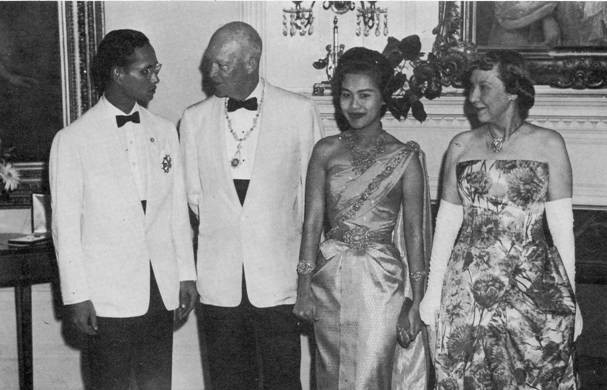The Queen of Thai Silk
Long before the Duchess of Cambridge became an ambassador for the best of her country’s fashion industry, Queen Sirikit of Thailand was using state visits to promote traditional Thai textiles and to revive interest in the traditional material at home.
In the late 1950s, Queen Sirikit was planning a series of state visits to the United States and fifteen European nations due to last seven months, and she recognized this would provide a tremendous opportunity to present a wardrobe that would convey Thailand’s rich cultural identity. As in so many other nations since the mid-19th century, royal court dress had become steadily westernized, and the government had even gone so far as to issue a decree in 1941 requiring all Thais to wear Western clothing in the belief that this would promote development, Thailand had no national dress equivalent to India’s sari or Japan’s kimono.
Surrounding herself with a team of advisors that included Thai fashion designer Urai Lueumrung and Pierre Balmain, the French grand couturier who was also designing her Western-style wardrobe for the tour, the beautiful young queen set about creating a contemporary take on a “traditional” royal wardrobe that would epitomize the traditions and craftsmanship of the kingdom internationally, using hand-woven Thai silk, either plain, brocade or patterned.
Drawing on diverse sources, including surviving court textiles and photographs of court ladies taken between 1850 and 1925, the team created a group of dresses based upon the wrapped and draped styles Thai women had traditionally worn — hip wrappers (phaa nung) and shoulder cloths (sabai) — but constructed according to contemporary Western dressmaking techniques.
Initially, there were five designs for the 1960s, three of these with simple wrap-around skirts and two with plated folds at the front. An additional three designs were later added to the collection thus creating the eight Thai national dress styles known as Thai Phra Rajaniyom (“Royal Favour”). The styles were all named by Queen Sirikit’s aunt Thanpuying Maneerat Bunnag based on important royal locations in the Grand Palace in Bangkok.
The royal's global tour in 1960 was a tremendous success and the Queen’s stylish elegance was widely acclaimed, helping to put a spotlight on Thailand and Thai fashion.
Though initially created for this world tour, the dresses proved so successful that the Queen continued to wear these styles of dresses and by the late 1960s, the more informal styles, Thai Ruean Ton and Thai Chitralada, had been adopted as uniforms by many Thai businesses, particularly airlines, hotels, and restaurants. Thai Women also started wearing the Thai Boromphiman dress on their engagement day or wedding day, says Alisa Saisavetvaree, curator of the recently opened Queen Sirikit Museum of Textiles.
Some of these original dresses are now showcased at the Queen Sirikit Museum of Textiles that is located in the Royal Palace Complex visited by thousands of international tourists and many Thais too.
Queen Sirikit’s support of the Thai silk industry has gone well beyond mere fashion statements. In 1976 she set up the Foundation for the Promotion of Supplementary Occupations and Related Techniques, known as the SUPPORT Foundation, to further encourage the production of traditional handicraft, particularly in northeastern Thailand where high quality silk ikat (mat mii) has been produced for hundreds of years as a cottage industry.
The new musem is also retracing some of her efforts through photographs and displays of silk production and weaving techniques. The state of the art museum presents a small collection of couture gowns, such as a stunning gold gown designed by the Queen’s favorite French grand couturier, Pierre Balmain, and made of silk ikat (mat mii) from northeastern Thailand trimmed with red dyed feathers from ostrich and chicken, and a striking blue gown embroidered by Maison Lesage of Paris with crystal beads and metallic silver thread on silk ikat, which was designed by Erik Mortensen for House of Balmain after Balmain’s death in 1983.
Piyanan Petcharaburanin, editor of Queen Sirikit Museum of Textiles’s various publications, says Queen Sirikit encouraged many designers to use the best of Thai silk by commissioning them gowns. Designs by Khunying Angsubha Panyacheewa, Yuthapong Meeprom, Tirapan Wannarat are also on display in the museum.
Building on the queen’s example, organizers of the recent Siam Paragon International Couture Fashion Week in Bangkok had asked the participating designers to use the silk for a runway presentation in her honor.
“The Queen of Thai Silk,” an invitation-only event,showcased 27 styles by Christophe Josse of France; Yumi Katsura of Japan; Lie Sang Bong, a Korean designer based in Paris; and Frederick Lee of Singapore. There were also three Thai designers: Chamnan Pakdeesuk of Flynow; Nagara Sambandaraksa for Nagara; and Sirichai Daharanont for Theatre.
“Thai silk has a very unique texture and design,” Mr. Daharanont said in an e-mail interview before the event. “It has a certain stiffness and shininess, and as a designer I would normally use it for sharp tailoring. But this time I’m focusing on draping and moulage.” He added that he had been inspired by the queen’s outfits during a visit to the museum.
As first published in Designare Magazine







